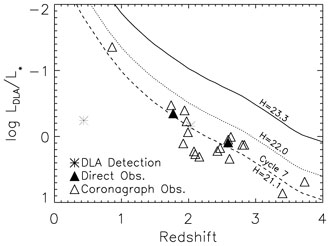


 FROM
PREGALACTIC OBJECTS?
FROM
PREGALACTIC OBJECTS?
Implicit in the previous discussion is the assumption that the "birth
of a galaxy" is operationally equivalent to the epoch of its first major
burst of star formation. This is usually the first chance we have
to detect objects which will eventually evolve into modern galaxies.
However, damped Ly absorbtion systems (DLAs), detected as neutral hydrogen
troughs (NHI ~ 1020 - 23 cm-2)
in the
spectra of high-z quasars, detect baryonic concentrations
independent of star formation or nonstellar nuclear activity.
DLAs contain most of the H I in the universe.
absorbtion systems (DLAs), detected as neutral hydrogen
troughs (NHI ~ 1020 - 23 cm-2)
in the
spectra of high-z quasars, detect baryonic concentrations
independent of star formation or nonstellar nuclear activity.
DLAs contain most of the H I in the universe.
Imaging searches for galaxies associated with DLAs are not new, but they have been almost impossible to carry out from the ground [19]. They are best performed in the near-IR, where the DLA starlight should be relatively bright compared to the background quasar. Unfortunately, a large enough H I column density to be detected as a DLA is only expected to occur at small impact parameters through a galaxy (or protogalaxy) - within 10 or 20 kpc of its center ([41]). This corresponds to a separation between the galaxy and the line-of-sight to the background quasar of less than 1 to 2 ". Detecting a faint galaxy this close to a bright source is exceedingly difficult from the ground. Adaptive optics is not yet the solution (beset by poor Strehl ratios). Proposed interferrometric techniques are more suitable for detecting a compact source at a known position angle with respect to the quasar (and still the required dynamic range may be unattainable). Ground-based imaging can discover DLA galaxies only at large impact parameters, greater than 25 kpc (for Ho = 75). To do better, an extremely sharp and stable PSF is required, preferably near the diffraction limit. This means going into space.
We therefore used the NICMOS-2 camera on the HST in coronographic
imaging mode to search for near-IR continuum emission from starlight
associated with two dozen DLAs. Our results are shown in
Figure 14.
Despite the approval of 95 targets, only two dozen
quasar observations were attempted, and
many were not as sensitive as they could have been. This low success
rate was because: 1) the coronograph was not fully
operational during the first half of Cycle 7, 2) SNAPSHOT proposals
utilizing the
coronograph were not scheduled for a few months after the coronograph
became operational, and 3) failure
of the coronograph to autonomously acquire several of the quasars
when they were scheduled resulted in a loss of those observations.
Despite these difficulties, we detected two likely DLA galaxies of ~
0.7L, and obtained upper
limits for nearly twenty DLAs
([5]).
Our 5 upper limits for the
continuum fluxes of the DLAs are
plotted in terms of L* versus redshift in
Figure 14.
Note that the vertical axis has logarithmic luminosity increasing
downwards-higher observations are more sensitive to fainter galaxies.
The only detections of possible DLA galaxies are shown
by the two asterisks.
The lowest curve is our measured sensitivity for Cycle 7;
filled triangles represent direct imaging, while open triangles
represent coronographic observations.
The middle curve shows our predicted sensitivity in a 1300-second
NICMOS integration, a half magnitude gain over our current limits.
Finally, the upper curve is the predicted sensitivity
of for "limiting" 10,000-second exposures, would push detection limits 2
mags fainter.
upper limits for the
continuum fluxes of the DLAs are
plotted in terms of L* versus redshift in
Figure 14.
Note that the vertical axis has logarithmic luminosity increasing
downwards-higher observations are more sensitive to fainter galaxies.
The only detections of possible DLA galaxies are shown
by the two asterisks.
The lowest curve is our measured sensitivity for Cycle 7;
filled triangles represent direct imaging, while open triangles
represent coronographic observations.
The middle curve shows our predicted sensitivity in a 1300-second
NICMOS integration, a half magnitude gain over our current limits.
Finally, the upper curve is the predicted sensitivity
of for "limiting" 10,000-second exposures, would push detection limits 2
mags fainter.

|
Figure 14. Upper limits to the 1.6
µm continuum emission from starlight
associated with Damped Ly |
There were only two plausible DLA detections and the best upper limits were H ~ 21.5 mag. When we account for the fact that more luminous galaxies are likely to have larger HI cross sections, we would have expected to detect 5 or 6 of the galaxies. If the DLAs were drawn from the general galaxy population, we should have detected 2 or 3 with 1.0L* or brighter, instead of zero. This discrepancy indicates that the luminosity function of DLAs is not consistent with the normal galaxy population. The objects associated with DLAs are on average fainter than normal galaxies we measure at either z = 0 or 3. Deeper NICMOS/HST imaging can test the possibility that they are produced by dwarf galaxies such as the Magellanic Clouds.
If deeper proposed NICMOS imaging of DLA systems continues to set even stricter upper limits on their continuum emission, it may be that DLAs trace a substantial baryon reservoir not associated with normal galaxies.
I thank James Colbert, Harry Teplitz and Erin Hicks for some of the figures from our ongoing research collaborations.